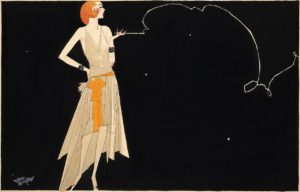The Fashions of the Opera
My husband and I are outliers in a number of ways, one of which is that we still dress up when we go to the theater or the opera. We’re both vintage enthusiasts as well and enjoy researching the proper attire for a particular era when we attend “period” (usually 1920’s) events. Well, we did, when going out was an option, and we can’t wait until it’s safe to do those things again.
Fans of Edith Wharton may recall that in The Age of Innocence, Ellen Olenska declines a last-minute invitation to the Old Met because she doesn’t think her dress is appropriate. Back in the day, dressing formally for the opera was not a matter of personal choice, as it is now – it was de rigueur. Certain evening clothes and accessories became popular because they looked great as one swanned around the lobby or checked out the occupants of the other boxes through – you guessed it – opera glasses. Some of these resembled miniature binoculars, while others were the lorgnette style – small spectacles attached to a folding handle or worn on a chain. They were made in a variety of materials, from enameled base metal to gold or silver set with gemstones.
Opera gloves were an essential part of a Victorian lady’s formal theater-going outfit and remained popular for many years. They are still worn by some brides, prom-goers, and gala attendees today. The most recognizable style of opera gloves is the mousquetaire – the long, over the elbow type with buttons near the wrist to allow the wearer to eat or drink without removing the gloves entirely. (Having sported this type of gloves on a few special occasions, I’d add that the greatest challenge in wearing them is often keeping them buttoned when you’re not at dinner!) They were usually made of silk or kidskin leather.
Of course, a woman attending the opera wouldn’t want to top off her Worth gown (or in later decades, her Lucille, Schiaparelli, or Balenciaga) with everyday outerwear. Nor would a gentleman finish off his top hat and tails with a casual coat. As such, the opera cloak was born! Men’s and women’s opera cloaks date back to the 1840’s and were made of flamboyantly colored silk or velvet, often trimmed in fur. As the Victorian era progressed, men’s formal cloaks were typically black, floor length, and fastened at the neck. Women’s opera cloaks and coats also came in black, although colorful ones remained in vogue as well. My personal favorites are the 1920’s and 1930’s silk velvet styles, which are quite collectible and continue to inspire designers today.
The opera hat, or top hat, as it’s now more commonly known, was invented in the 19th century. A London hatter named Thomas Francis Dollman came up with the brilliant idea of creating a collapsible top hat that could easily be stored under one’s theater seat or in the cloak room. These hats were made of the finest silk, so they didn’t come cheap, which made them an aspirational fashion purchase for men in the growing middle class.
Even jewelers got in on the act and gave certain pieces theatrical names that are still in use. These days, a matinee length pearl necklace is typically 20-24 inches long, while an opera length strand is 26-35 inches. My own opera length pearls are about 28 inches long as there are only 63 inches of me.
Back when far more people smoked, even cigarette holders were made in formal styles and lengths considered appropriate for elegant occasions. If you’ve seen Breakfast at Tiffany’s, or just a certain famous photograph of Audrey Hepburn, you’ve seen an opera length cigarette holder. They typically ranged from 16 to 20 inches long! Shorter theater length holders were also made in 10 to 14 inch styles. These were marketed to women; men’s cigarette holders generally didn’t exceed 4 inches in length. Some were made of affordable materials like Bakelite, but they could also be found in gold, silver, and ivory, embellished with precious or semi-precious stones. Plain or fancy, cigarette holders served a number of practical purposes, including reducing the amount of staining to a smoker’s teeth and keeping ashes off of one’s clothing. It must have required quite a bit of grace and poise to keep from getting ash on others when wielding a lit cigarette in a 20-inch holder while navigating a crowded theater lobby. The original social distancing tool, perhaps?
Tags:fashion, lorgnette, music, opera, opera cloak, opera coat, opera glasses, pearls, retro, theater, vintage





